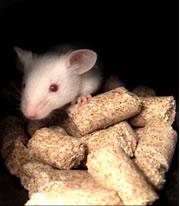 Losing the desire to borrow is an early sign of CJD infection for mice.Melanie White and Michael Farmer
Losing the desire to borrow is an early sign of CJD infection for mice.Melanie White and Michael FarmerA man walks around the neighbourhood with his family, and stops to admire a particularly lovely house. He turns to his family and asks who built it. "You did," they reply.
It was the first sign that something was wrong, he would later recount to researchers at the University of California, San Francisco. But it was another half a year before he developed the classical erratic behaviour and unsteady gait typical of Creutzfeldt-Jakob disease (CJD) — a neurodegenerative condition caused by an infectious protein called a prion.
A diagnosis of CJD is a death sentence, and researchers around the world are looking for a cure. But that cure is unlikely to do much good if doctors can't diagnose the condition in its early stages, before the patient develops severe brain damage.
Now, researchers have characterized the early signs of a similar prion disease in mice. In results presented this week in Neuron1, the researchers show that shutting off production of the pathogenic protein during these early stages allowed mice to not only survive, but also recover normal brain function.
Mouse model
CJD occurs spontaneously in about one in every million people, and 90% of patients die within a year of their initial diagnosis. Variant CJD occurs in a much smaller proportion of the population and has been linked to infection by a prion found in cattle.
To investigate how the disease progresses, Giovanna Mallucci of the Medical Research Council's Institute of Neurology in London and her colleagues infected mice with an abnormal prion protein. Mice are known to develop a neurological disorder from this treatment: three months after injection the mice stop grooming themselves; they then develop an unsteady gait, and eventually die.
Mallucci's team monitored two other aspects of mice behaviour — their ability to remember familiar objects and their desire to burrow into pellet-filled tubes. They found that infected mice began to lose their ability to distinguish between new and familiar objects and lost interest in burrowing around eight weeks after infection — well before the classical signs of prion disease start to appear.
The mice were also engineered with a genetic trigger that allowed researchers to shut off production of the prion protein. When this was done in the 8th week after infection, the mice returned to normal behaviour within a week. This was a surprise. Although Mallucci had previously shown that shutting off the protein halted progression of the disease2, they did not know that the mice could also recover. "We realized we weren't just prolonging survival," says Mallucci.
Not so easy
No one is proposing that humans be genetically engineered to turn off prion production, but the results are encouraging, says Michael Geschwind, a neurologist at the University of California, San Francisco who was not involved in the study. "It's very hopeful," he says. "It reinforces the notion that we have to develop methods for making the diagnosis early."
Geschwind and his colleagues have surveyed hundreds of patients with CJD, and have found that cognition and behaviour often show small changes months before the disease is diagnosed. If an astute spouse or physician could pick up on these early clues, then their observations could be followed up, he proposes.
ADVERTISEMENT
The results could have implications for other neurodegenerative diseases like Alzheimer's and Parkinson's disease, says Howard Federoff, a neurologist at the University of Rochester in New York.
But the complete reversal of early symptoms seen in mice may not be reproducible in humans. The mice used in this experiment were young, and their brains were probably in a better position to recover than those of older mice. "While this is exciting, it may not work for people who typically get CJD in their fifties and sixties," says Federoff "there may not be enough plasticity even if they are caught early."
Furthermore, the genetic switch used in the mouse model depleted the prion protein to levels that would be difficult to achieve using drugs or other therapies. "I'm optimistic about these strategies," says Federoff, "but I think it's unlikely that we'll see the remarkable reversal demonstrated in this paper."
Visit our diseasereversedinmice.html">newsblog to read and post comments about this story.
